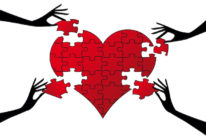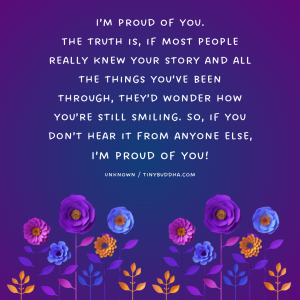
“I’ve discovered that you can’t change people. They can change themselves.” ~Jim Rohn
“As much I want you to be happy, I’m realizing that I can’t be responsible for your happiness.”
I had never spoken truer words in my life. Even as the tears flowed down my cheeks, I felt a profound sense of freedom and lightness.
My mother suffers from major depressive disorder. For much of my life I truly believed that there was something I could do to bring her out of it. I tried to be the perfect daughter. I minimized my own emotional presence. I did everything I could to make her smile.
Yet nothing I did seemed to make any difference in her mood.
Though I couldn’t articulate it as a child, I felt I was to blame. I hadn’t been entertaining, engaging, or good enough to keep her from feeling sad.
I internalized my mother’s moods until I was no longer able to tell the difference between what she was feeling and my own emotions.
I didn’t give myself permission to express any of the emotions I perceived to be negative, such as anger, sadness, guilt, or shame. It seemed my mother had sole ownership of these, so I suppressed them within myself.
As I got older, I began to interact in much the same way with romantic partners, friends, and others I encountered. Like a chameleon, I took on the emotions of other people and was greatly affected by their moods.
Most of my relationships were unhealthy and unsatisfying, involving varying levels of codependency.
I felt trapped within myself. I grew tired of pretending. I craved emotional freedom.
Then my therapist said something that completely changed me: “It is okay to feel angry, sad, disappointed, or frustrated”
For me, this was a revolutionary idea, and extremely empowering. I didn’t think it was acceptable to be anything other than happy and “perfect.” Once I gave myself permission to feel these things, I noticed that these emotional experiences did not consume me as much as they once did.
I felt liberated.
Emotional Freedom = Emotional Separation
Becoming an emotionally healthy and mature adult involves developing a sense of emotional separation from others, particularly caregivers.
This requires you to experience and establish emotional boundaries by being clear about the difference between your emotions and the emotions of others around you. You learn to take greater personal responsibility for your emotional experience and are less likely to seek and attract codependent relationships.
Give yourself permission to experience a wide range of emotions.
Oftentimes, we hold this idealized image of how we should be, feel, and act in the world. We believe that emotional health means completely eliminating “negative” emotions and being in a state of perpetual state of happiness and bliss.
This is simply not true. Expecting yourself to be happy all the time is completely unrealistic and unhealthy. Instead, allow yourself to feel whatever you may be feeling at a particular moment.
Don’t try to label these emotions initially. Don’t try to understand or analyze them. Don’t assign them a positive or negative value. Simply allow them to exist and experience them as they come. Be patient and compassionate with yourself.
Learn to identify your emotions.
After you have become comfortable with experiencing your emotions, it’s helpful to learn to identify them.
Most of us have a very limited emotional vocabulary. We tend to be extremely familiar with the major emotions: happiness, sadness, anger. However, we are less familiar with the broad range of emotional experiences that aren’t fully captured by these terms.
What you may experience as anger might actually be disappointment. Perhaps the guilt you think you’re feeling could best be described as resentment. Take some time to develop a deeper level of self-awareness so you can accurately describe your emotional experience.
One tool that was extremely helpful for me was an emotional vocabulary chart. I would carry this around with me and check in with myself several times a day. I began to see patterns in my emotional experiences. I truly began to observe, understand, and accept myself more fully.
Again, the point is not to assign judgment or to determine why you are feeling a particular emotion. When you question why, you may assume that something is wrong with the feeling you are having. You are merely observing and identifying in order to develop greater self-awareness.
Learn to express your emotions.
Expressing your emotions to others is an important part of healthy and mature communication.
Consider the following statements.
“You made me angry.”
“I feel angry.”
Did you notice any differences?
There is a subtle but powerful shift in emphasis between the two. The former places blame and assumes that the other person is responsible. This often leads to defensiveness and can shut down further efforts at communication.
The latter effectively communicates the same feeling, but eliminates blame and indicates a personal acknowledgment and acceptance of the internal experience. This is an example of something known as perceptual language, which I’ve found is a powerful tool for learning how to communicate in a more mature and healthier way.
It becomes more of a report than an accusation. In my experience, these types of statements are better received by others, and also give me a greater sense of control.
In communicating your emotions, it’s not only about the words you say. Your intention is also extremely important. Be sure you’re not expecting the other person to make you feel better. This often leads to anger, frustration, and disappointment. Instead, find ways to soothe and comfort yourself.
Allow other people to have their own emotional experiences.
Once you’ve given yourself permission to feel and identify emotions within yourself, it becomes much easier to separate yourself from the emotional experiences of those around you.
Just like you, other people must be accountable for their own emotional experiences. Allow them to experience, identify, and express their emotions in their own way.
Once you have clearly defined emotional boundaries, you no longer hold yourself responsible for other people’s emotions. This ultimately leads to healthier, more deeply satisfying relationships.
About Alana Mbanza
Alana Mbanza is a freelance writer and the author of LoveSick: Learning to Love and Let Go. Even more than a writer, she strives to be an active agent of creation, choosing to see and create life through the lens of love. Visit her website for more information about her freelance writing and coaching services.













 Though I run this site, it is not mine. It's ours. It's not about me. It's about us. Your stories and your wisdom are just as meaningful as mine.
Though I run this site, it is not mine. It's ours. It's not about me. It's about us. Your stories and your wisdom are just as meaningful as mine. 